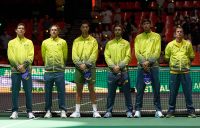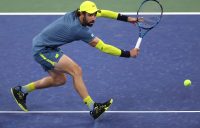Melbourne VIC, Australia, 22 September 2014 | James A Crabtree, Australian Tennis Magazine
OK, don’t get ahead of yourself. For the time being this has nothing to do with having a new haircut, buying the latest Roger Federer outfit or a fresh dose of Botox.
There is also no need to stay up late watching infomercials, waiting for some energetic American guy to promise you an absolute tennis overhaul in a 12-step program in just three easy payments. There is a little more to it than that.
This is about changing your game. The way you play. The way you go about playing. Adjusting a shot, tweaking a grip, altering your racquet tension or maybe just learning to stay calm under pressure. The change needn’t be drastic, although the repercussions of your modifications can be. So how do you know when you’re in need of a game makeover? These sure signs will help you diagnose a tennis facelift for the better:
You’re not seeing results
As simple as ABC, if you’re not getting the results you’re looking for then it’s time to examine your game and look for a much needed change. What’s initially seen as disciplined play can over time develop into predictable, easily readable tennis. No player wants to find themselves in a rut so don’t wait for the double bagel to tap you on the shoulder, if your results aren’t impressing you then it’s time to see the tennis plastic surgeon.
You’re uninspired
If the thought of tennis no longer excites you then this is a sure sign that you need a refresh. Tweaking shots or mixing up game play can bring back the spark you once had and ignite your tennis fire.
You’re too comfortable
You beat the same player every week, or even worse, you lose to the same player every week but it doesn’t worry you. Playing on autopilot makes tennis a no-brainer but you’re only cheating yourself if you no longer break a sweat. By challenging yourself you will feel a sense of accomplishment that will not only motivate you further but also enable you to excel to heights you could never imagine.
Help me, doctor
Now that you know you’re a makeover candidate it’s time to make the all important assessment. Remember the first step to any amazing transformation is the ability to want to change. And don’t worry, this won’t hurt a bit.
The Big Shots
You don’t have to wait long when watching a match on television to hear the commentators talk about the benefits of a good serve and a big forehand. These are without question the two major shots that rule the game.
Would Novak Djokovic have become world No.1 if he hadn’t fixed his serve? Would Steffi Graf have won a single Slam without her forehand? Would Richard Gasquet be a top 10 player without that backhand? When thinking of the great players who have dominated the game the vast majority had at least one of these weapons.
They also have a wonderful knack of making the strokes look smooth and effortless. Not only that but they stop trying to muscle the ball and use the body’s natural flow to find results.
Serve
Considering you can’t play a match without one, it’s amazing how little time is spent practising it. Alas, when it is practised it is usually without direction. The majority of club players out there are going for the thunderbolt. When was the last time you took out a bucket of balls, placed targets in both the service box and along the back fence? We want the serve in, but we also want it to find some angle after the bounce.
Now, there are tonnes of things to consider when making over the serve. Some may include keeping the elbow up higher, bending your legs, taming the ball toss and pronating the racquet arm rather than muscling it.
Makeover approach
For the makeover we need to lose a little testosterone. Think of the majority of male players at any club that will attempt to break their arm for that Andy Roddick bomb. Failing that is the daisy-do floater second serve that would leave your grandmother laughing.
The problem here is psychology. Returners step back warily for the first serve and forward imposingly for the second. Miss the first serve and your opponent is already setting up their line drive. Keep the psychological edge and take 15 per cent out of your first to make sure you get the ball in. Without even realising, you will be smiling like you are 10 years younger.
Forehand
Since the birth of tennis the strokes have been changing. The forehand swing, for instance, keeps on growing in both velocity and range. For players coached 40 years ago the swing stopped in front of the eyes. Nick Bollettieri and the subsequent 1990s American Revolution professed a stroke that should finish high over the shoulder. Following this is the current trend of ripping the stroke across the body, in a windscreen washer fashion from pocket to pocket. We can only wonder how the strokes of Rafael Nadal’s disciples will look, and a generation of junior players inspired by his famed “lasoo forehand”.
When a good player is going through a bad time the first shot they will question is the forehand. The big problem here is there are so many aspects to think about and question.
Do you loop your back swing or just drop the racquet and flick? Is your grip of the extreme Spanish variety with knuckles underneath the handle, or is it a pure one for all strokes like John McEnroe?
Is your stroke all power and no spin or all spin and no power? Are you bringing the off hand into play for body torque and extra rotation?
Makeover approach
What we want is a quick fix and a happy makeover.
We don’t want you fretting about a stroke that could leave you with therapy bills to pay. Don’t even think about that arm of yours, just work on the feet. Most of the time poor footwork is to blame for an errant stroke. Even when the ball is coming directly at us, most fail to split step and prepare. Let’s face it, most of us never even get off our heels.
Fix the problem by watching the flight of the ball back to your opponent and getting that little bounce in your step as your opponent hits the ball. Once your feet are activated it will be easier to stay alert, step forward and gain momentum on your next shot.
Homework – Watch Andy Murray highlights for his bounce and great shot preparation.
The Grey Areas
These are the shots most of us rarely practise; the half and high volley. Incredibly, they are so forgotten that most of us don’t even think of them as strokes. The important thing about hitting these strokes successfully is that it will give your game a feeling of indestructability while sending a message to your opponent that you can handle anything.
Half volley
Most professional players will start a practice session warming-up from the service line, hitting complete strokes softly. This not only helps to get your eye in but also gain a feeling for the ball on the strings and what it does when you send it back.
Makeover approach
From the service line starting point you can work on the forgotten shots. Have your partner come forward to volley down at your feet. Bend your knees, keep your back straight and keep your swing short and neat. Before you know it voila! You will be scrapping back shots that will make your timing look ninja quick.
Homework – Watch Pete Sampras footage, he could scrap back anything.
High Volley
Any volley above shoulder height leaves many people perplexed. Is it a smash, is it a volley or is it something to run away from and get back to the safety of the baseline?
Makeover Approach
Between you and me, and for the best practice ever get greedy poaching balls during your next doubles match. Every volley is yours, reach up and go for glory! Importantly, practice a sheepish grin if your partner gets angry.
If you are a bit scared of your doubles partner and really don’t want to upset them there is a more traditional practice:
- Start at the service line and have your partner feed a floater as you approach the net.
- Keep your eye on the ball and don’t let your arm go limp.
- A progression would be to hit the ball firmly at them and have them try and pass you on the next shot for game action simulation.
Fitness, tactics and equipment
Fitness
The beauty of fitness is that anyone can do it to gain an edge. Offset an opponent’s talent for your dedication to hard work. The only requirement being that you must willingly motivate yourself to do that extra run, hour in the gym or cardio session. In truth once we hit the court we usually know by the end of the warm-up how in (or out of) shape we actually are.
Tactics
Streamline your game by altering strategy and court positioning. Simple techniques such as standing closer to the baseline will rush your opponent or take the pace off the ball to unravel a big hitter. Look for combinations in match play. Consider that soft players go even safer on game points, and big hitters hate to rally when the game is close. Additionally moving the ball around the court will render a lazy opponent useless.
Tactical moves may be subtle in nature but they can give your game the recharge it may need. Call them stealth moves.
Equipment
Players often buy a new racquet when all they need is a change of strings. The biggest change tennis has seen in the past 10 years is spin. So upgrade your game and create more spin than a politician. Remember the general rule and think of your string bed as a trampoline, loose low tension for power, tight high tension for placement. If you are a “once a week” warrior, a new set of strings should be sufficient once per season.
Another forgotten aspect is your grip. No, we are not talking about the semi-western, continental and eastern options. We are talking about the physical grip, the one that looks like it’s been clawed at by a cat. If it hasn’t been changed in a while your racquet handle could be rotating before you have even finished your stroke causing unnecessary misses.
While minor adjustments can be beneficial, a complete overhaul can be dangerous and finding what works for you will be a gradual process. When Pete Sampras switched from a double to a single-handed backhand during his formative years most of his compatriots thought he was doomed. Stefan Edberg did the same, whereas Djokovic switched to a double handed early on for strength reasons. In contrast, McEnroe, a serve and volley genius, spent his early junior years as a baseline scamper. Very few players in their prime have success from making drastic changes to their game, although it is not impossible.
One notable exception to all the rules is Australian Paul McNamee who took a break and changed to a double handed backhand while already a top 100 player, with immediate success on his return. A risky change, and dare we say the tennis version of a botox injection, in just three easy payments.






